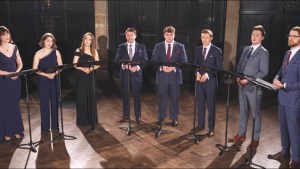VOCES8, the esteemed singers of a cappella music both sacred and modern, are back with a lovely hymn from the pen of Gustav Holst. Freshly released on October 16, this exceptionally performed rendition of “Nunc Dimittis” will likely raise goosebumps and those little hairs on the back of your neck.
“Nunc Dimittis” is an ancient hymn that draws its lyrics from the Latin Vulgate. While today’s featured version from Holst was written in the early 20th century, the lyrics of “Nunc Dimittis” have been put to song and chanted since at least the 4th century. It is the canticle usually recited or sung at the close of Compline, or Night Prayer, in the Liturgy of the Hours.
The hymn is also called the Song of Simeon, as it comes from the passage of Luke 2:29-32 in which child Jesus is presented at the Temple. Simeon was a devout Jerusalem man, to whom the Holy Spirit revealed that he would not die before he had seen the Messiah of the Lord. With Jesus in his arms he prayed:
“Now, Master, you may let your servant go
in peace, according to your word,
for my eyes have seen your salvation,
which you prepared in sight of all the peoples,
a light for revelation to the Gentiles,
and glory for your people Israel.”
The Latin lyrics of the hymn are an exact recitation of the passage from Luke, however it also includes the “Glory Be” prayer, which is traditionally added at the end of a New Testament canticle in the Liturgy of the Hours. Holst’s version makes the distinction between the biblical passage and the “Glory Be” especially pronounced, as the music entirely changes.
While the song begins as quietly as a prayer – which is fitting as Simeon was talking with a 40-day old Jesus in his arms – once the “Glory Be” starts, the music is much more dramatic and full of jubilation. It is a nice response to the biblical passage, as Luke’s writings convey how belief in Jesus Christ removes all fear of death, while the “Glory Be” could be seen as giving thanks to the Lord for removal of such fear.
Follow VOCES8 on YouTube to hear more and keep up with all their releases.



